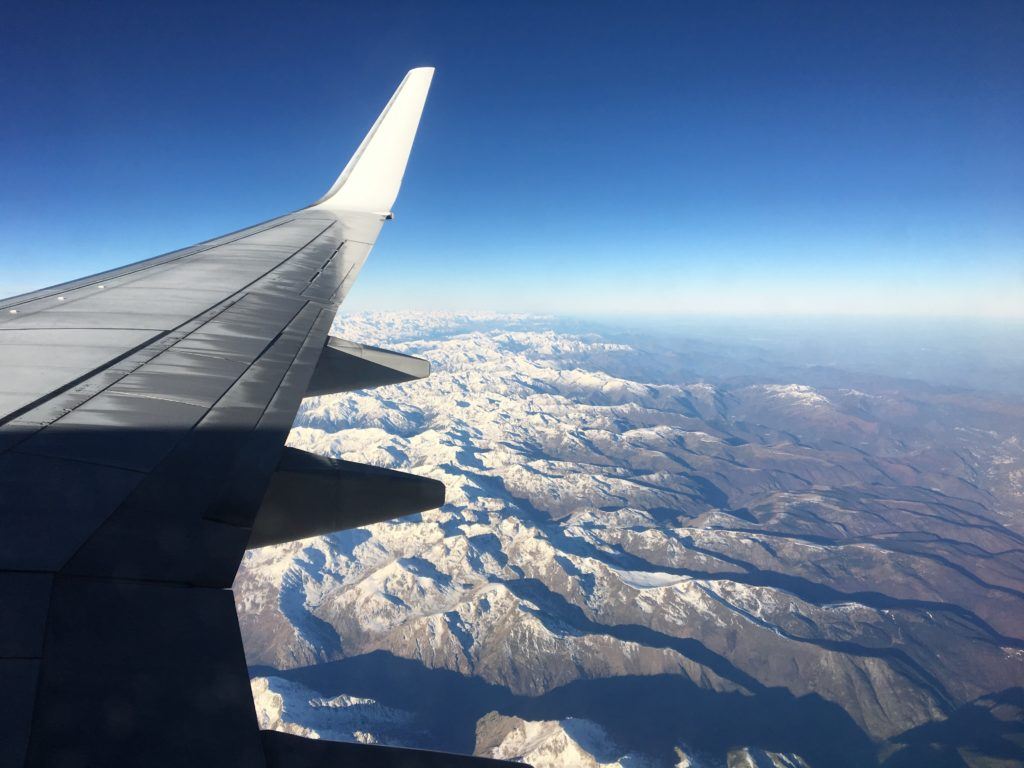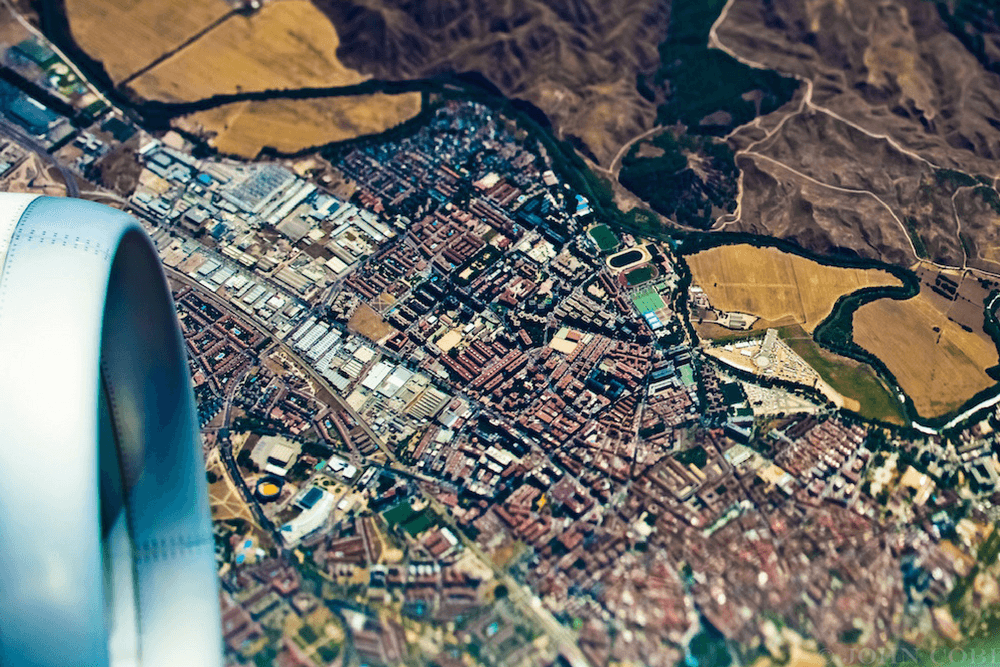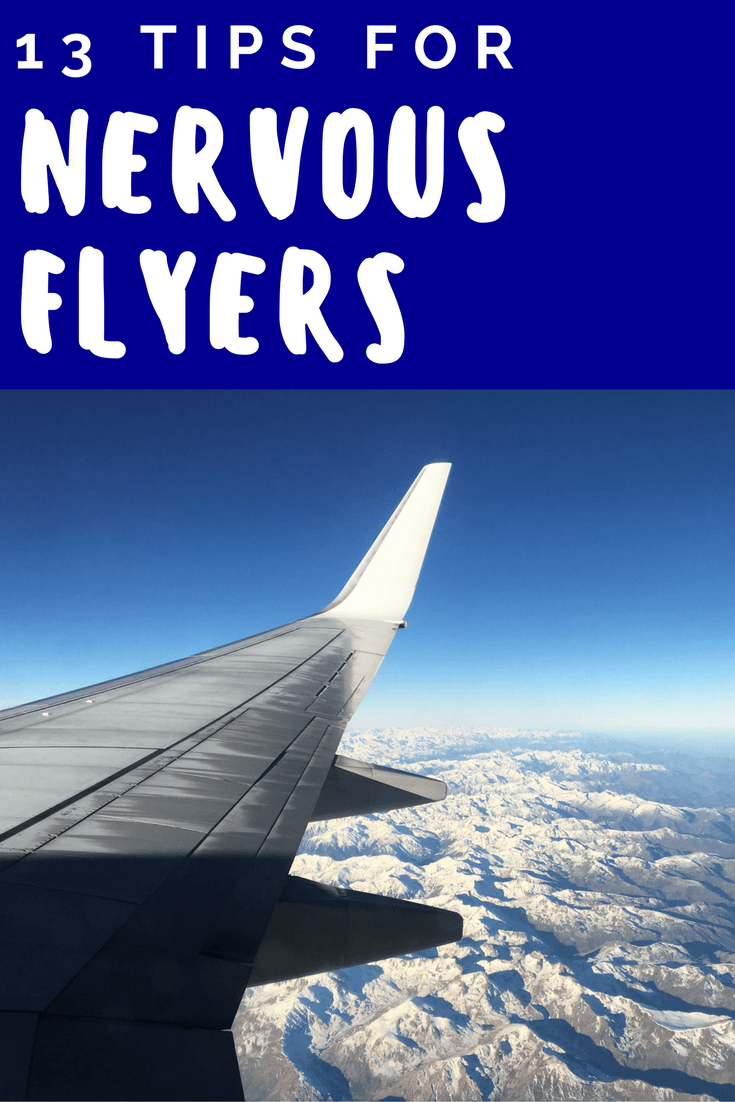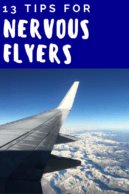13 Tips For Nervous Flyers: Practical things nervous flyers can use to reduce anxiety from flying, and stay calm before and during a flight.

Disclosure: This post contains affiliate links. That means we earn a commission when you use the links on this site to book a hotel, buy your travel insurance, etc. If you’d like to learn more about how this works, you can read more under our Disclaimer page.
***
I’m marking 2016 down as the year my (until now) life-long love for flying came to an end.
Following one white-knuckle flight from Mexico City to Puerto Vallarta last Spring — a flight during which people legitimately screamed from the turbulence — and the Brussels and Istanbul airport attacks, my ability to enjoy flying feels tapped out.
Gone are the days when I’d be a barely contained ball of energy upon take-off, confidently settling into my seat for the miracle of human flight, and ready to enjoy the experience and view along the way.
Instead, flying now feels like something to be endured, and I feel myself fighting anxious energy from airport to airport. When we’re flying a lot — like in the past month — my nerves decrease as the whole process begins to feel normal. But if we go too long without taking a flight, getting back into the swing of it is painful.
As not flying is not an option for us, I’ve slowly worked out ways to manage my nerves before and during a flight. And since I know there are many, many people out there who also get nervous during a flight, I thought I’d share what works for me.
First, a few pre-flight tips for nervous flyers.
1. Get Super Comfortable
Being comfortable makes everything slightly better. For me, that means an in-flight uniform of loose-fitting layers like leggings (Amazon is a good bet for cheap and comfortable leggings), a loose tunic, a cozy sweater wrap, and warm, soft socks.
For longer flights, it probably also means getting a squishy neck pillow with a soft covering and an eye mask if you want to try sleeping.
Finally, bring a good carry-on bag that fits under the seat in front of you and will hold all your activities, so you don’t have to unbuckle your seatbelt to access your music, headphones, coloring books, etc!
2. Avoid the News
Reading about increased risks of terrorist attacks (and airplane disasters) stresses me out in the best of times, never mind how it messes with my head in the days before a flight.
As the unfortunate reality is the news is filled with these kinds of stories these days, both of us do our best to avoid the news in the days before we fly. If you see a headline, scroll on past it. And make a habit of saying no to the free in-flight newspaper, especially if it’s a sensationalist tabloid (nods to the Daily Mail).
3. Focus on What You Can Control
One of the worst parts of flying, in my opinion, is that you have no control over your fate. And while this is true in a lot of things in life, if feels more blatantly obvious while on an airplane.
There are parts of the experience, however, that you can control. I don’t like taking my seatbelt off until about 30 or 40 minutes into a flight, once we’re at cruising altitude. Knowing that, I try not to chug coffee or water before boarding, lest I have to immediately pee.
On our turbulent flight from Mexico City to Puerto Vallarta, Geoff and I weren’t sitting next to each other — something we both immediately regretted once things got a bit rough. Seat assignment is something I can partially control, and now I do.
What about in-flight tips for nervous flyers?
While Geoff most-often conks out into an epic power nap as soon as he buckles up, for me, the trick is to find something that engages my mind and distracts me from the fact that I’m on an airplane, but doesn’t require any serious amount of actual concentration. The trick is to find something that, once you start, will simply pull your focus into the task and engulf your attention, without really having to work at it.
4. Podcasts
Listening to podcasts works really well for me, because they engage my attention in a story, don’t require concentration, and block out a lot of the dreaded mystery airplane noises that are totally normal, but still concerning (especially if you splurge for some noise-cancelling earbuds). If it’s something I’m really interested in, even better, because then I get more engaged and excited about the topic, and forget to be nervous.
5 Podcasts I’m Listening To Right Now
- The Allusionist goes into the history, science and etymology of language. Episode 4, Detonating the C-Bomb, tackles the “rudest word of all” and contains — as the title might suggest — a lot of swearing. Episode 46 delves into the 50 mottos of each American state. Episode 44 goes into how your brain makes sense of language. Funny, fascinating, and great fodder for your next dinner party.
- Longform is an extension of its namesake website, which highlights long-form non-fiction stories from around the interweb, and is described as a weekly conversation with a non-fiction writer on how they tell stories. Each episode covers a range of interesting stories, new and old.
- The Urbanist is about the future of cities. In the words of its publishers, this is Monocle’s guide to making better cities, be it new technology, state-of-the-art subways or compact apartments. I find urban planning and futurism fascinating, so a single episode that tackles issues facing Cairo, Buenos Aires and Brazil, all from the point-of-view of designers, policy-makers and people who are actually changing cities around the world, is a little piece of heaven.
- Tough Girls Podcast is a motivational podcast featuring stories of women who’ve overcome big challenges. Think endurance athletes, adventurers, stunt women, scientists. A nice little motivation boost.
- Planet Money is broadly about economics, but simplified and made entertaining and understandable through storytelling. Take economics and history of economy topics that you’ve never thought about before — like how light has been essential to economic growth, or how Russia is trying to get into the steak game — and then allow yourself to be entertained by it.
5. Music
If podcasts aren’t your thing, try building a playlist before your flight, making sure it’s long enough to last your entire flight, or at least good enough that you won’t mind repeating it. Personally, music doesn’t engage me enough to distract me, but we have friends who swear by making Flying Isn’t Scary playlists.
For me, music is best used with one of the other strategies, like visualizing, writing, or organizing, and mostly as a way to block out the scary airplane noises.
If you are going to use podcasts or music as one of your distraction methods, pick up a decent pair of headphones before your flight.
There’s nothing worse that settling in for a listen and having your earbuds constantly fall out or hurt your ears (cough, cough, Apple, cough). If you have the cash, my husband swears noise-cancelling headphones are a game changer. Two top headphone picks include the (splurge earbuds) Bose Quiet Comfort 20 Earbuds and the (more affordable) TaoTronics earbuds.
6. Eavesdropping
Call me a jerk, but I find eavesdropping on other people’s conversations to be comforting, as long as they’re having an up-beat and not-confidential vacation-ish conversation. By concentrating on what others on the flight are saying, it gets me out of my head and reminds me to put my feelings in perspective compared to the feelings of those around me.
Just knowing others aren’t nervous helps me feel less so.
7. Writing
Confession: I am typing this blog post on my phone’s notes app while on a flight from Edinburgh to Barcelona, and the simple act of writing has moved my mind away from catastrophic failure.
I find writing – something, anything, as long as it’s not too mentally taxing – helps divert my attention. So bust out your to-do list, write a story or a letter to a friend, or start a blog. Whatever works to shift your attention.
As I am “stationery motivated,” I always pack a cute travel-themed notebook in my carry-on. If you’d rather use the flight to catch up on correspondence with friends, bring a set of letter-writing stationery and check ‘being an awesome, mail-sending friend’ off your to-do list.
8. Organizing
If I have any boring, mindless organizing tasks related to my computer files, I use time spent on airplanes to get ahead of them. Typically, this means organizing my external hard drives, which are full of photos from past trips.
Organizing travel photos is one of my favourite in-flight organizing tasks because it’s pretty mindless, engages my attention, and reminds me why I’m on this flight in the first place: to travel and do something I love.
Goes great with music or a podcast.
9. Coloring
Okay, so this is admittedly a wee bit self- promotional, BUT coloring seriously does help. That whole zen mindfulness aspect of adult coloring is absolutely true, and ever since we’ve gotten into adult coloring, I now bring a selection of pencil crayons and one of our coloring books with me and colour in flight.
This is another activity that goes great with listening to music or a podcast.
If adult coloring isn’t your thing, try picking up a orrelatively easy crossword book pre-flight. Again, the goal is to have something to focus your attention on, without requiring too much effort.
Now for a few tips for nervous flyers who freak-out during flights
10. Study The Flight Attendants’ Faces
Every time the airplane makes a strange noise, scan the cabin for a flight attendant and notice their completely calm, non-plussed facial expression.
Every time the ‘bing bing’ sounds comes on – such as when you’re climbing or when you reach altitude – my initial instinct gravitates toward mini freak out. When the speaker comes on for an announcement: mini freak out. When we hit even the tiniest amount of turbulence: mini freak out.
In all of those situations, my eyes search for the flight attendants and I focus on their faces, which are calm, chipper, and going about their normal everyday job. I figured if they aren’t worried, I don’t need to be either.
11. Look Out The Window
Whenever I hear a sound I don’t recognize, the plane makes a turn, or we make (what feels to me like a sudden) change in altitude, I look out the window to orient myself. I find it helps to see the position of the airplane in relation to the horizon or ground, and to know we’re ticking along just fine, despite the unexpected change.
Further, there’s often gorgeous scenery out the window, which is worth appreciating. They say gratitude reduces stress, and if you’re sitting in an airplane heading somewhere you want to go, that’s probably something worth being grateful for.

13. Visualization
Visualization is amazingly effective if you work at it. For me, it works best during turbulence, when I imagine I’m on a speed boat.
I have a specific memory from when Geoff and I were in Thailand and were taking a boat from Koh Tai back to the mainland about 5 years ago. Sun in my face, fresh air, the smell of salt and the tropics, and blasting through the waves. Whenever we hit a bit of turbulence, I imagine I’m back on that boat.
If you find you’re not able to visualize on your own, there are a number of free visualizations on the internet – some of them are pre-recorded, and some are scripts you can record for your own personal use, and listen when needed.
That’s it for me. What tips and techniques do you have for staying calm before and during a flight? What tips for nervous flyers do you use?
Like this post? Share it on Pinterest


